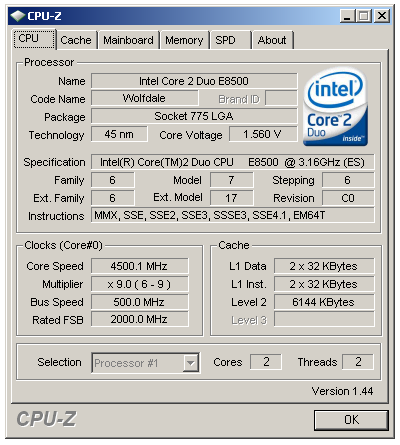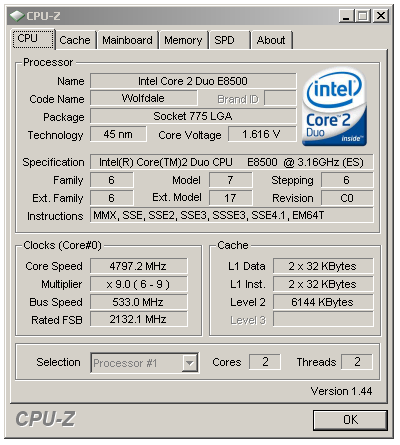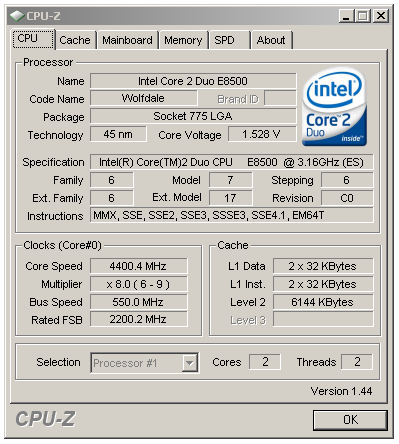Intel's 45nm Dual-Core E8500: The Best Just Got Better
by Kris Boughton on March 5, 2008 3:00 AM EST- Posted in
- CPUs
E8000 Lineup and Early Overclocking Results
Intel plans to introduce no fewer than four new 45nm dual-core processors as part of its Q1 2008 Wolfdale launch. At the time of publication, the following models are scheduled for immediate availability:
- E8200, 2.66GHz, 6MB shared L2 cache, 1333MHz FSB, maximum 8.0x multiplier
- E8300, 2.83GHz, 6MB shared L2 cache, 1333MHz FSB, maximum 8.5x multiplier
- E8400, 3.00GHz, 6MB shared L2 cache, 1333MHz FSB, maximum 9.0x multiplier
- E8500, 3.16GHz, 6MB shared L2 cache, 1333MHz FSB, maximum 9.5x multiplier
Estimated street prices, although unconfirmed and subject to change, are expected to be around $299 for the E8500, $249 for the E8400 and $163 for the E8200. As you can see, each processor features a maximum multiplier - there has been no formal mention of an "Extreme Edition" dual-core processor at this time. Additionally, rumors of the impending release of an E8600 processor (presumably running at 3.33GHz with a 10x multiplier) go unconfirmed. It it becomes available, the E8600 may very well be the CPU to own as it would allow for operation at 10x400 (4GHz), a very good place to be when it comes to tuning in maximum memory performance.
Unlike the Conroe release, all processors will make use of the full 6MB shared L2 cache offered on the top-end E8500 model. Undoubtedly, a 45nm Celeron or Pentium line (or E5000/E7000 - choose your favorite naming scheme) will eventually make their way to retail. We expect these to come in at 3MB and/or 1.5MB of shared L2 cache. Based on what we have seen when it comes to 65nm Pentium E2000 and Core 2 E4000 chips, when they do arrive the 45nm variants will offer tremendous value and an amazing price/performance ratio.
 Designed to run at an already fast 3.16GHz, this E8500 is just starting to stretch its legs and show its true potential with some water-cooling TLC. |
We were able to overclock our E8500 sample all the way to 4.5GHz with water-cooling; what's more, we were able to demonstrate complete stability at these speeds running many hours of Prime95, a popular tool for stress-testing systems. Most X6800/X6850 owners will attest to this amazing achievement - the average overclock for top-bin 65nm CPUs falls somewhere near the 3.8 ~ 4.0GHz mark. Results such as these combined with Wolfdale's modest clock-for-clock advantage over Conroe show the prospect of 15% or more processing power when overclocking. Even though the official frequencies may not have changed significantly (yet) - a new maximum of 3.16GHz, up from 3.00GHz - this increase in overclocking headroom makes the E8500 a marvel to behold.

Our top (unstable) overclock on water is nothing short of impressive. Although we were unable to benchmark up here, future steppings may change that. The ability to POST and load Windows at 4.8GHz on water promises more to come….
A quick maximum-frequency run on water indicates the proverbial sky's the limit when it comes to overclocking the E8500. The maximum achievable frequency had more to do with our nerves than anything else. Given the voltage, our E8500 was more than happy to continue scaling higher. However, we eventually said enough is enough and called it quits - that point came when we were subjecting our poor 45nm CPU to over 1.6V, a level that could possibly require you hand over your credit card number in exchange for another CPU in no time flat. Quite simply, we believe any voltage over 1.45V is asking for trouble with 45nm processors and our conversations with Intel to date have all but confirmed our suspicions.

The E8500 is no slouch when it comes to chasing a high FSB. Of course, all of this will be for naught when Intel releases their next-generation Nehalem architecture.
Here's the obligatory high-FSB screenshot, for those that care. In case you missed it, we recently had an in-depth article on why high FSB overclocking might not really be the best approach to take when dialing in maximum system performance. Suffice it to say, our fascination with these displays of CPU or motherboard worthiness is rapidly waning. However, we are also not so stubborn as to not acknowledge the importance of high FSB potential when it comes to pushing processors with low multipliers. Our recommendation is straightforward, however: buy the model with the highest multiplier that you can possibly afford. Most motherboards (and systems) are far happier running 9x490 than 8x550.










45 Comments
View All Comments
TheJian - Thursday, March 6, 2008 - link
http://www.newegg.com/Product/Product.aspx?Item=N8...">http://www.newegg.com/Product/Product.aspx?Item=N8...You can buy a Radeon 3850 and triple your 6800 performance (assuming it's a GT with an ultra it would be just under triple). Check tomshardware.com and compare cards. You'd probably end up closer to double performance because of a weaker cpu, but still once you saw your fps limit due to cpu you can crank the hell out of the card for better looks in the game. $225 vs probably $650-700 for a new board+cpu+memory+vidcard+probably PSU to handle it all. If you have socket 939 you can still get a dual core Opty144 for $97 on pricewatch :) Overclock the crap out of it you might hit 2.6-2.8 and its a dual core. So around $325 for a lot longer life and easy changes. It will continue to get better as dual core games become dominant. While I would always tell someone to spend the extra money on the Intel currently (jeez, the OC'ing is amazing..run at default until slow then bump it up a ghz/core, that's awesome), if you're on a budget a dual core opty and a 3850 looks pretty good at less than half the cost and both are easy to change out. Just a chip and a card. That's like a 15 minute upgrade. Just a thought, in case you didn't know they had an excellent AGP card out there for you. :)
mmntech - Wednesday, March 5, 2008 - link
I'm in the same boat with the X2 3800+. Anyway, when it comes to dual vs quad, the same rules apply back when the debate was single versus dual. Very few games support quad core but a quad will be more future proof and give better multitasking. The ultimate question is how much you want to spend, how long you intend to keep the processor, and what the future road maps for games and CPU tech are within that period.I'm a long time AMD/nVidia man but I'm liking what Intel and ATI are putting out. I'm definitely considering these Wolfdales, especially that sub $200 one. I'm going to wait for the prices and benchmarks for the triple core Phenoms though before I begin planning an upgrade.
Margalus - Wednesday, March 5, 2008 - link
the current state of affairs generally point to the higher clocked dual core. Very few games can take advantage of 4 cores, so the more speed you get the better.Spacecomber - Wednesday, March 5, 2008 - link
This has been mentioned in a couple of articles, now, that what these processors will run at with no more than 1.45v core voltage applied is what really matters for most people buying one of these 45nm chips. So, it begs the question, what are the results at this voltage?While the section on processor failure was somewhat interesting, I think that it should have been a separate article.
retrospooty - Wednesday, March 5, 2008 - link
"these processors will run (safely) at with no more than 1.45v core voltage applied is what really matters for most people buying one of these 45nm chips. So, it begs the question, what are the results at this voltage"Very good point. Since these CPU's are deemed safe up to 1.45 volt, lets see how far they clock at 1.45 volts. 4.5 ghz at 1.6 volts is nice for a suicide run, but lets see it at 1.45.
Spoelie - Wednesday, March 5, 2008 - link
This reads like an excerpt of a press release:"We could argue that when it came to winning the admiration and approval of overclockers, enthusiasts, and power users alike, no other single common product change could have garnered the same overwhelming success."
Except that it was not. It was a knee-jerk reaction to the K8 release way back in 2003. It was too expensive to matter to anyone except for the filthy rich. The FX around that time was more successful. In recent years they just polished the concept a bit, but gaining admiration and overwhelming success because of it?? I think not. The Conroe architecture was the catalyst, not some expensive niche product.
"Our love affair with the quad-core began not too long ago, starting with the release of Intel's QX6700 Extreme Edition processor. Ever since then Intel has been aggressive in their campaign to promote these processors to users that demand unrivaled performance and the absolute maximum amount of jaw-dropping, raw processing power possible from a single-socket desktop solution. Quickly following their 2.66GHz quad-core offering was the QX6800 processor, a revolutionary release in its own right in that it marked the first time users could purchase a processor with four cores that operated at the same frequency as the current top dual-core bin - at the time the 2.93GHz X6800."
Speed bump revolutionary? Oh well ;)
No beef with the rest of the article, those two paragraphs just stand out as being overly enthousiastic, more so than informative.
MaulSidious - Wednesday, March 5, 2008 - link
this articles a bit late isn't it? seeing as they been out for quite a while now.MrModulator - Wednesday, March 5, 2008 - link
Well it's being updated from time to time. I think it is relevant since Cubase 4 is still the latest version used of cubase and the performance is the same today. What is important with this is that they measure up two equally clocked processors where the difference is in the number of cores. Yes, the quad is better at higher latencys but it loses the advantage at lower latencys and even gets beaten by the dual-core.More of a reminder of the limitations of current day quadcores in some situations. This will probably change when Nehalem is introduced with its on-die memory controller, a higher FSB and faster DD3 memory.
adiposity - Wednesday, March 5, 2008 - link
Uh, what? I think he's saying these processors were on the shelves over a month ago. This article is acting like they are just about to come out!-Dan
MrModulator - Wednesday, March 5, 2008 - link
Yeah, you talk about games and maximum cpufrequency on dual core is important, but there are other areas that are much more interesting. Performance for sequencers where you make music (in DAW-based computeres) is seldom mentioned. It is very important to be able to cram out every ounce of performance in real-time with a lot of software synthesizers and effects using a low latency setting(not memory latency but the delay from when you press a key on the synt until it is procesed in the computer and put out from the soundcard for example).Here's an interesting benchmark:
http://www.adkproaudio.com/benchmarks.cfm">http://www.adkproaudio.com/benchmarks.cfm
(Sorry, using the linking button didn't work, you have to copy the link manually)
If you scroll down to the Cubase4/Nuendo3 Test you can compare the QX6850(4 core) with the E6850 (2 core). They both run at 3 GHz. Look at what happens when the latency is lowered. Yes the dualcore actually beats the quadcore, even though these applications use all cores available. The reason could be that all 4 cores compete for the fsb and memory access when the latency is really low. Very interesting indeed, as DAW is an area in much more for cpu than gaming...